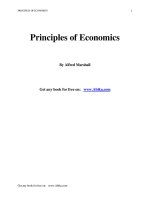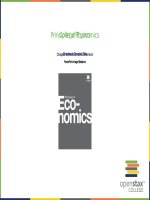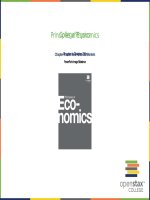Principles of economics openstax chapter29
Bạn đang xem bản rút gọn của tài liệu. Xem và tải ngay bản đầy đủ của tài liệu tại đây (717.8 KB, 13 trang )
College
Principles
ofPhysics
Economics
Chapter
# and
Chapter
Title
Chapter 29 Exchange
Rates
International
Capital Flows
PowerPoint Image Slideshow
Figure 29.1
Is a trade deficit between the United States and the European Union good or bad for the U.S. economy? (Credit: modification of work by Milad
Mosapoor/Wikimedia Commons)
Figure 29.2
Expectations of the future value of a currency can drive demand and supply of that currency in foreign exchange markets.
Figure 29.3
Exchange rates move up and down substantially, even between close
neighbors like the United States and Canada. The values in (a) are a
mirror image of (b); that is, any appreciation of one currency must mean
depreciation of the other currency, and vice versa. (Source:
/>
Figure 29.4
Exchange rate movements affect exporters, tourists, and international investors in different ways.
Figure 29.5
(a)
The quantity measured on the horizontal axis is in U.S. dollars, and the exchange rate on the vertical axis is the price of U.S. dollars measured in
Mexican pesos.
(b)
The quantity measured on the horizontal axis is in Mexican pesos, while the price on the vertical axis is the price of pesos measured in U.S. dollars.
In both graphs, the equilibrium exchange rate occurs at point E, at the intersection of the demand curve (D) and the supply curve (S).
Figure 29.6
An announcement that the peso exchange rate is likely to strengthen in the future will lead to greater demand for the peso in the present from investors
who wish to benefit from the appreciation. Similarly, it will make investors less likely to supply pesos to the foreign exchange market. Both the shift of
demand to the right and the shift of supply to the left cause an immediate appreciation in the exchange rate.
Figure 29.7
A higher rate of return for U.S. dollars makes holding dollars more attractive. Thus, the demand for dollars in the foreign exchange market shifts to the
right, from D0 to D1, while the supply of dollars shifts to the left, from S0 to S1. The new equilibrium (E1) has a stronger exchange rate than the original
equilibrium (E0), but in this example, the equilibrium quantity traded does not change.
Figure 29.8
If a currency is experiencing relatively high inflation, then its buying power is decreasing and international investors will be less eager to hold it. Thus, a rise
in inflation in the Mexican peso would lead demand to shift from D0 to D1, and supply to increase from S0 to S1. Both movements in demand and supply
would cause the currency to depreciate. The effect on the quantity traded is drawn here as a decrease, but in truth it could be an increase or no change,
depending on the actual movements of demand and supply.
Figure 29.9
The scenario of international borrowing that ends on the left is a
success story, but the scenario that ends on the right shows what
happens when the exchange rate weakens.
Figure 29.10
A nation may adopt one of a variety of exchange rate regimes, from floating rates in which the foreign exchange market determines the rates to pegged
rates where governments intervene to manage the value of the exchange rate, to a common currency where the nation adopts the currency of another
country or group of countries.
Figure 29.11
Even relatively stable exchange rates can vary a fair amount. The exchange rate for the U.S. dollar, measured in Japanese yen, fell about 30% from the
start of 2002 to the start of 2005, rose back by mid-2007, and then dropped again by early 2009. (Source:
/>
Figure 29.12
(a)
(b)
If an exchange rate is pegged below what would otherwise be the equilibrium, then the quantity demanded of the currency will exceed the quantity
supplied.
If an exchange rate is pegged above what would otherwise be the equilibrium, then the quantity supplied of the currency exceeds the quantity
demanded.









